The 2020 Amputee Cats Quality of Life survey results are in! A big thanks to our feline Tripawds members who participated. We received 35 surveys from cat parents and today, we’ll spotlight what they had to say about life on three legs.
2020 Amputee Cats Quality of Life Survey Results
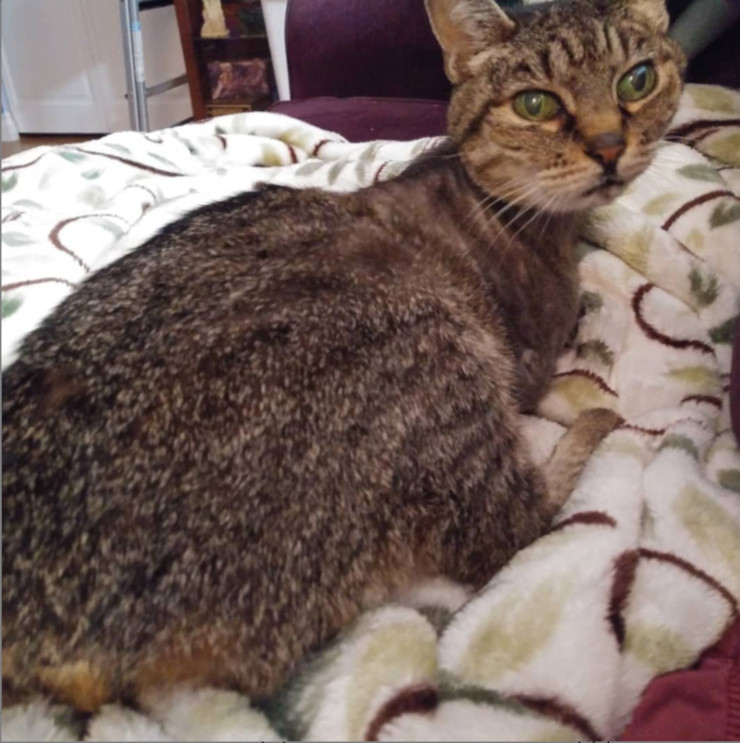
The last time we asked the Tripawds community about their post-amputation experience was in 2014. We are so glad we asked again! It’s always an honor to glimpse into the lives of our three-legged members.
Our survey questions are always based on the very first Amputee Pets Quality of Life Survey published by Dutch researchers in 1999. Twenty one years after that original survey, and six years after our community’s last Tripawds Quality of Life survey, here’s what 2020 feline Tripawds members had to say about how their cat adapted to amputation.
Download 2020 Tripawd Cats Quality of Life Survey
.xls file to Read All Responses and Comments
Why Do Cats Lose Legs?
Unlike our canine friends, it appears that cats loose legs for two big reasons: cancer and accidents. Some say their cat showed up at an animal shelter with a broken limb, and one person said their cat was caught in a car engine. Yikes! Only one person specified the type of cancer their cat had, which wasn’t a surprise: a feline injection site sarcoma.
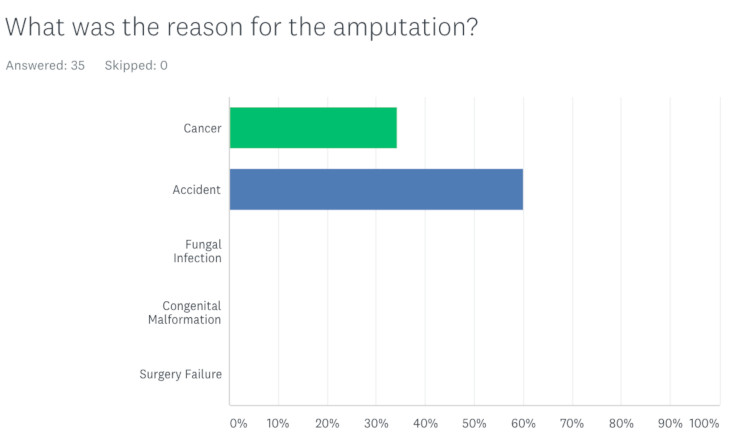
What Size are Most Amputee Cats?
Unlike dog parents, cat parents typically don’t hesitate to amputate when a cat is unusually large. But most people said their cat was under 10 pounds (4.5 kg) at the time of amputation.
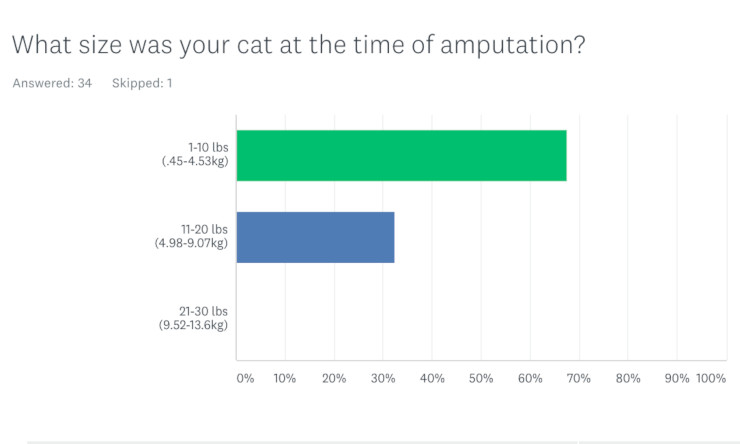
Do People with Senior Cats Amputate?
Like dogs, cats typically lose limbs in mid-life. A few senior cats did too.
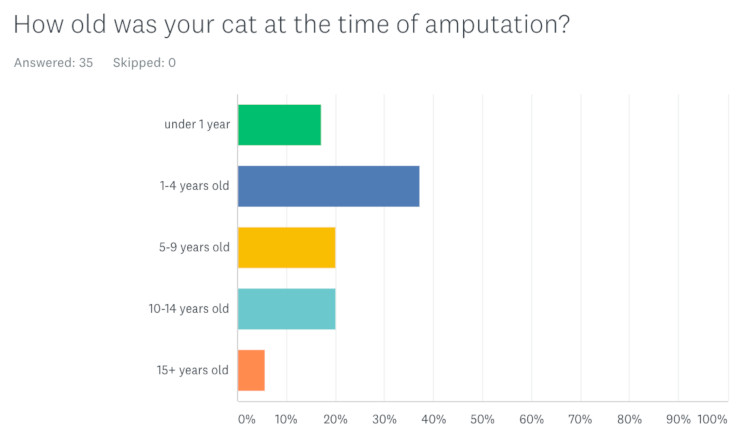
How Many Front Leg and Hind Leg Amputee Cats?
It appears that a large percentage of cats lose rear legs. This may be in part because of the large number of feline injection site sarcoma diagnoses.
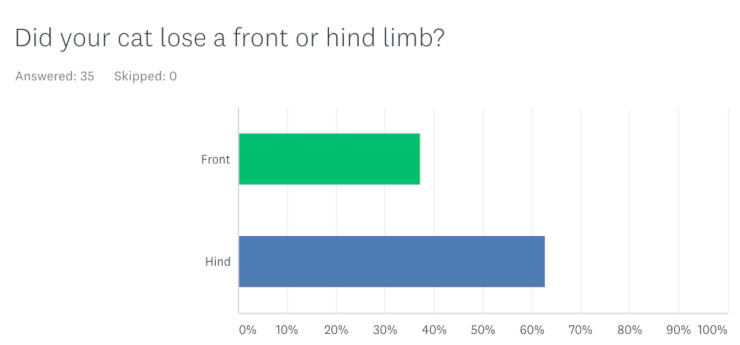
Were You Opposed to Amputation?
Nobody wants to amputate, but when the alternative is unthinkable, most of us give the go-ahead, even though it’s painful for us to say yes.
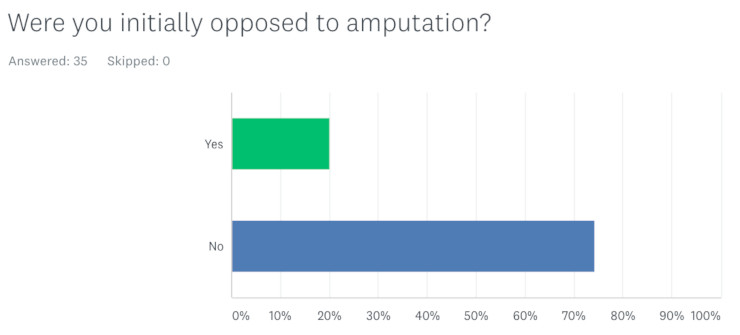
I kind of knew it was coming when I found the lump. It was harder for my husband to accept so I had to present the science (including stories on your site) to convince him without pressuring him.
We only had 2 options, amputation or euthanasia. We just wanted to save his life. We were horrified at the idea of having an amputee that was totally feral, but we did not want to put a young cat to sleep.
I was not opposed but I was extremely worried. Our surgeon was very thorough in explaining our options. He said pins, surgeries, and a cast would be far harder on our cat than a full amputation.
Wanted to do everything I could to ensure there was no other option. Once I knew there wasn’t, went ahead with the feeling it was the best I could do for her.
When the doctor told us the cancer was contained to the leg at the time, we were OK with moving ahead.
The amputation was done shortly before we met and adopted our cat, so we had no say in the situation, but we were concerned about what it would mean for both us and our cat for her to be missing a limb.
Approximately how long did it take for your cat to adapt to limb loss?
Recovery time is a big concern of pet parents. For those with cats, rest assured that most people say it only took about a week for their cat to adapt. A complete recovery, however, sometimes takes time. A few cats experienced difficulties like ongoing pain, which is why it’s so important to find a veterinarian experienced with modern pet pain management.
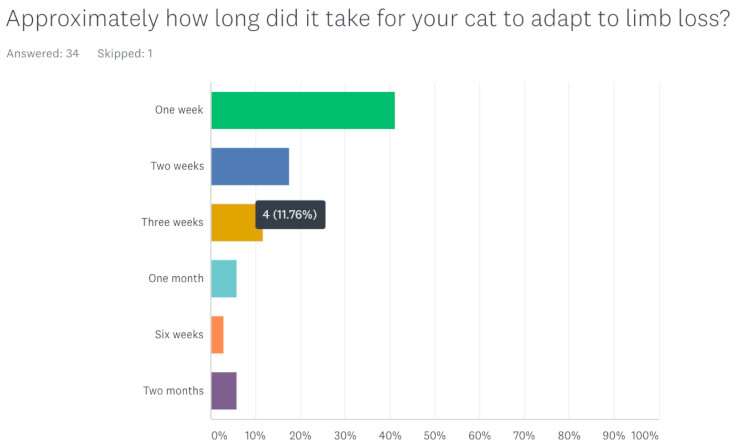
- it’s been 2 months and she still has lots of symptoms of pain.
- It took my cat 4 months to recover.
- Physically. Psychologically it took almost a year
- She was roughly 90% adapted after two months, but probably took 6-12 months to fully adapt.
- She adapted quickly but we had to restrain her movement bc she had an issue with healing and had to be on cage rest extra long. She even had to have a revision surgery
- I got him about 2.5 months post-amp, and he seemed adapted by then.
How would you describe your cat’s adaptation to limb loss?
Ssssh. Don’t tell cats, but they tend to adapt to amputation faster than dogs! Although one person commented that it “Took longer than average for his personality to come right,” the majority of people say their cat easily bounced back.
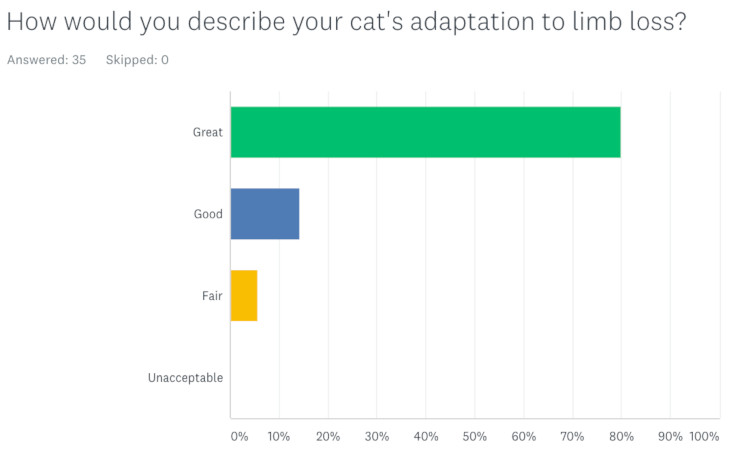
- I don’t think she knows she is supposed to have 4 legs!
- When I visited her in recovery, she already looked and acted like she felt much better without that leg.
- We didn’t know our cat before her amputation but cared for her while she healed. She has made a full recovery and is very healthy.
- I always tell people if Maxwell could choose, he wouldn’t want another leg.
- He gets around just as well as the others. He hops up on to one of our laps if he needs scratches in a place that he cannot get to.
- I also have a 4-legged cat, and their quality of life is comparable.
Did your cat show any behavior changes after limb loss?
Based on the stories you’ll read about below, it seems that some cats tend to have some interesting behavior changes after amputation that play out in different ways.
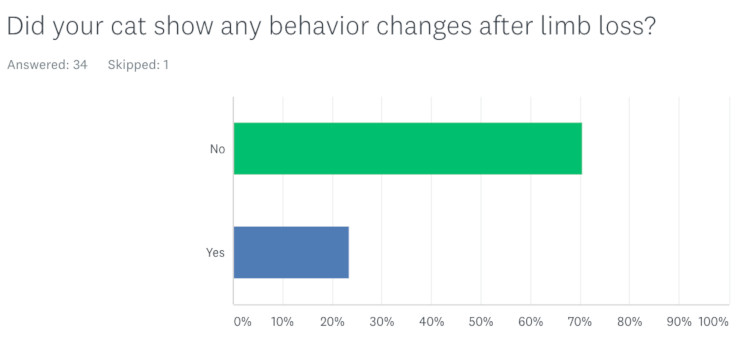
- I’m assuming so. She growls, chews and licks the amputation sites frequently. At average, I would say every hour. However, now at 2 weeks post the tail amputation, it seems to be a little less, maybe average of every 2 hours. I’m hoping the trend down will continue for her. I am at the point of decreasing her pain medicine and hoping she will be able to tolerate it.
- He was depressed.
- Our tripod was head of the house pre-amputation 2/2019. A few days after her amputation one of the cats tried to stage a coup and attacked her violently. She wasn’t physically injured but it took almost a year of careful attention, confidence building, and patience before she was comfortable being out in the whole apartment. Her nemesis has to be separated from her, but we have a good careful system to switch them out while keeping the neutral cats minimally impacted.
- After amputation and pain management it was quite evident that the broken leg that he had was very painful. He seemed less painful after the procedure.
- Her behaviour changed to adapt to 3 legs. After I set up boxes so she could dismount safely from the bed, couch, chairs, etc., she chose to use the boxes rather than suffer from faceplants. Obviously, she noticed the difference and has now claimed the boxes as hers. She has become more bossy, determined and confident. She seems to now enjoy car rides and is comfortable at the vet clinic. Perhaps I just know her better now.
Did you expect your cat to adapt to limb loss in a shorter or longer period of time? Or did it happen in the timeframe you expected?
This one is interesting. It’s almost a 3-way split between Tripawd cat parents recovery timeframe expectations.
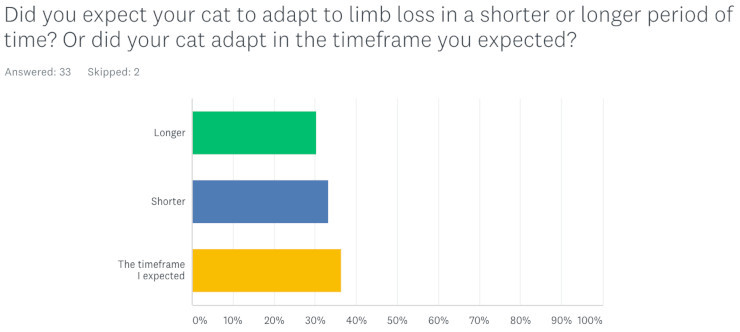
and finally, Tripawd cat parents answered the biggest question of all:
Would You Say Yes to Amputation Again?
Here’s the heart of our amputee pets survey. Despite the occasionally recovery challenges and ups and downs, every single person who answered our Amputee Cats Quality of Life Survey said yes, they would do it again.
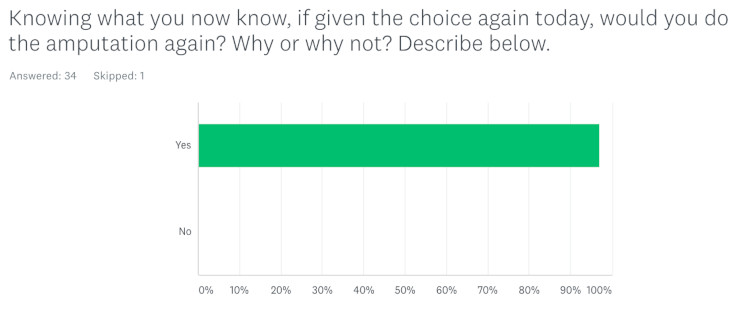
Yes I would, because I was amazed at how quickly he adapted to life as a tripawd and how well he recovered. I was scared at first and my spouse and I thought we would be sad everytime we looked at him, but its actually the opposite. My cat is still full of energy, jumps, runs (very fast!) and plays as if he never had surgery. I also did some research before making a decision on whether or not to amputate (or having the surgery to try and fix the broken bones, where the recovery time was extremely long and might have been painful/risk of infection, etc.) I don’t regret my decision at all.
Yes! To eliminate the pain of her front limb osteosarcoma so she can have a peaceful life.
Yes! This was a traumatic injury.
Yes! It saved her life and didn’t change anything about her personality. She was 17 when she had the amputation. She’s 20 now and going strong.
Yes! After four long months of anguish and uncertainties he has recovered well and is even playing and runs after his ball. I also rely on him for support especially now during this Coronavirus pandemic, because of him I’m able to laugh.
Yes! It’s been a rough year but she’s doing great and has shown incredible resilience. Sadie is my hero! My husband also agrees that it was absolutely the right thing to do.
Yes! It saved her life. It would have killed me to put her down because of a broken leg.
Yes! Huckleberry is one of the sweetest, most loving cats that you could ever meet. Domestication took a lot of love and hard work, but it proved time and time again to be a worthwhile venture. I am so glad that we took the chance with him, he is a wonderful companion and he could care less that he has only three legs. It does not hinder him at all.
Yes! Even though it took a long time, he is still the happiest cat he was before it just takes time. I know now not to listen to average recovery times as not all cats are the same. My cat took longer than average but at least he came right and is now doing amazing as ever!
Yes! She’s her happy self. With what we were given, it’s all I could hope for.
Yes! It made his quality of life so much better. Without the amputation, we would have been discussing end of life. We were able to give him almost 3 more years before cancer came back.
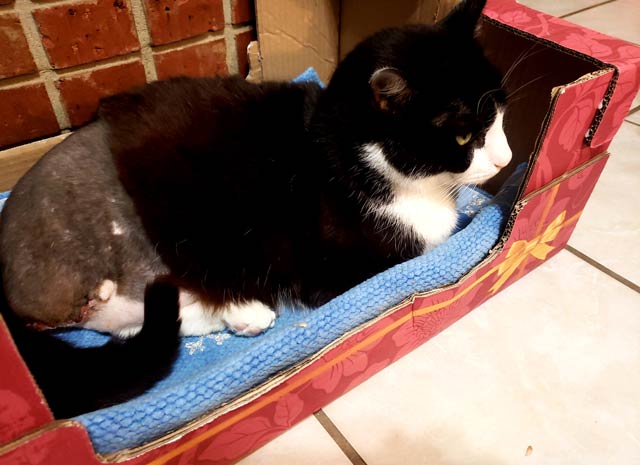
That’s it for the 2020 Amputee Cats Quality of Life Survey!
Download 2020 Tripawd Cats Quality of Life Survey
.xls file to Read All Responses and Comments
Watch for next week’s article that reveals Amputee Dogs Quality of Life Survey results, and in the meantime if you’re a feline pet parent, be sure to stop by Tripawds 3 Legged Cats Discussion Forum to say hello!
 Join the forum discussion on this topic!
Join the forum discussion on this topic!
I have a tripod kitty about 15yrs old. Her front leg had to be amputated because someone shot her with a bow and the arrow went right through both bones. Her leg was taken off at the shoulder. My concern is she is having trouble getting up and down. Thinking about making some kind of prosthetic leg to help keep her level. She seems to fall on her shoulder. Do you think it will help her ????
I have a tripod kitty about 15yrs old. Her front leg had to be amputated because someone shot her with a bow right through both bones. Her leg was taken off at the shoulder. My concern is she is having trouble getting up and down. Thinking about making some kind of prosthetic leg to help keep her level. She seems to fall on her shoulder. Do you think it will help her ????
Sue, thank you for giving your kitty a great life on three. We really encourage you to have her evaluated by an animal rehabilitation therapist. They can guide you to help her get and stay strong. A DIY prosthetic can do more harm than good. Tripawds Foundation can pay for your first rehab visitt too!
My cat has had phantom paw extremely bad from being declawed he’s 13 now in been on a lot of different medications but still having a lot of attacks he’s been monitored by Vet for 6 years now in he might have to have that one front paw off that has phantom I would never declaw another cat again he’s my baby in I don’t know what to do ?
Sorry to hear about your kitty! Please post in the Three Legged Cats Forum for much more feedback from tri-kitty members.
My plump cat (Mazikeen) is a tripawd now, 3 weeks ago.
2 Neighborhood dogs tried to rip her apart.
I think is been harder on me. All I can think about is the moment when it was happening and the feeling for her.
She’s terribly more spoiled than she used to be, more mischievous, more complaining, but she made it through the ordeal.
Would I do it again? OF COURSE I WOULD!
My 10-year-old male (neutered) cat has a large lump on his front leg. After talking with the vet, our options are to remove the lump (running the risk that some tissue will get left behind and regrow) or to amputate the whole leg, guaranteeing no regrowth. Given that our cat is otherwise very healthy (blood work came back normal and an x-ray of the chest showed no growths around the lungs/heart), I am leaning towards total amputation to eliminate the risk of the mass returning. However, my husband is taking a more pessimistic view and doesn’t think our cat will live more than 6 months, max, post-surgery, no matter which option we choose. Do you have any clinical studies or resources I can share with him to help show him that – given George’s otherwise very healthy state – his chances of living several more happy, healthy years are probable?
Hi Cheryl, I’m sorry to hear about your cat, and when the other person responsible for an animal doesn’t agree on amputation it makes the situation that much tougher. Prognosis really depends on the individual diagnosis and since you didn’t say what kind of cancer your cat has, I can’t even point you to resources that may give a better idea on expected longevity. You oncologist definitely can. One thing your husband needs to wrap his head around is that nothing guarantees tomorrow, with or without cancer. Another illness could come along, your cat could pass from something else, or not. Even very old Tripawd cats can live a lot longer than 10 y ears, even after amputation. I encourage you both to join our Forums to come ask more questions. Hope to see you there.
my cat lost her hind leg in 2021 and she us down to 6.8 lbs and when took her to vet last year she was 8 lbs and never was a big eater like most cats. Do i need to worry about the weight change?
Hi Cheryl,
I’m in the exact same position. Front left tumor around the paw. We did have it removed because at the time the biopsy came back negative, however deeper into the tumor proofed to be cancer and about a month or so after the growth removal, it has regrown 2x the size. Our bubba goes in Monday for his full front left amputation. He just turned 10 in August and has always been an indoor cat. I’m banking on another 5-10 years of life based on previous indoor cats lifespans and based on my own personal research on tripod cats. I know the procedure is expensive but I wouldn’t want him to suffer through radiation only to lose the limb in 6 months to a year. My vets have been very helpful answered all my questions. Maybe have your husband attend the next consultation to ask his specific questions.
Ryan thank you for sharing. We hope your kitty has a speedy recovery. Please keep us posted in our Forums, we are here for you!
Hello, we are a week out from having Nibbles necrotic hind leg amputated. She is using a tray as a litter box. She seems bewildered by the cone collar, which is necessary, as she tries to pull out her stitches. Do yiu think she will eventually use her box like before? I ordered a larger senior box, as the other was too small. I am hoping for less mess.
Hi Rosemarie. Glad to know Nibbles is on the mend! Yes she will use her litterbox like before but it’s best if the sides are lower so it’s easier for her to get in and out. See our Litterbox Tips for Tripawd Cats, and join us in the Discussion Forums so we can help you better. See you there!
Not sure if I can ask questions here but my kitty had her leg amputated about a year and a half ago and she seems to be in pain but when I try to give her pain meds it’s so tramaNot sure if I can ask questions here but my kitty had her leg amputated about a year and a half ago and she seems to be in pain but when I try to give her pain meds it’s so traumatic for her. She hates it so I’m not sure which is worse. Any advise? Do cats usually end up with chronic pain from this?
Hi Rebecca, thanks for posting. You are better off posting in our 3-legged cats discussion forums so that our community can better help you OK? For now, it does sound like that pain needs to be addressed by a rehab therapist. Yes Tripawds are more susceptible to chronic pain over time but there’s plenty of things you can do. Medication is just one part of it. Also see our new Tripawd cats book for tips! Hope to see you in the forums.
I still have guilt about our cat’s broken leg because it happened on my watch. I have no idea what happened to her but there she was, holding her back leg up and limping. Nothing could be done to save the leg; it was necrotic. The vet said the amputation would hurt us more than Maddie, and she was 100% right. I still long for the days when Maddie would jump into my lap, but this is pretty damn good.
Doug, thank you sooo much for sharing Maddie’s story! How wonderful that things turned out so well. Feel free to post in our 3-legged cats forum anytime, we’d love to follow along on your journey with her.